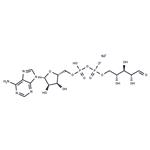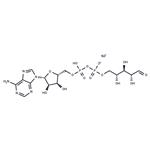Adenosine 5′-diphosphoribose sodium (ADP ribose sodium) is a nicotinamide adenine nucleotide (NAD+) metabolite. It is the most potent and primary intracellular Ca2+-permeable cation TRPM2 channel activator and can also enhance autophagy.
5′-Deoxy-5′-(methylthio)adenosine has been used:
- to give a range of nicotinamide adenine dinucleotide (NADH)
- oxidation rates for the respiratory complex (CI/CIII/CIV)
- CI/alternative(AOX) pathway
- to measure poly(ADP-ribose) glycohydrolaseactivity
- poly(ADP-ribose) (PAR) binding competition assay
- oxidase?(AOX) pathway
- to measure poly(ADP-ribose) glycohydrolase activity
- poly(ADP-ribose) (PAR) binding competition assay
ADP-Ribose is used as the basic building block used as a substrate in the formation of poly(ADP-ribose) by members of the poly(ADP-ribose) polymerase (PARP) family. Poly(ADP-ribose) formation and degradation are an important components of DNA repair and apoptosis signaling.
In mouse embryonic fibroblasts (MEFs), H2O2 treatment demonstrates that the activation of poly(ADP-ribose) (PAR) polymerase-1 (PARP-1) produced Adenosine 5′-diphosphoribose (ADP ribose), which is an activating signal for TRPM2 channels, thereby promoting Ca2+ elevation through extracellular Ca2+ influx and (or) lysosomal Ca2+ release. This process eventually activates early or late autophagy in response to different degrees of oxidative stress.
TRPM2 channels are activated by binding Adenosine 5′-diphosphoribose (ADP ribose) to the intracellular NUDT9-homology (NUDT9-H) domain unique to TRPM2 and located at its C terminus. In addition to ADPR, intracellular Ca2+ is an essential coactivator: TRPM2 channels open only in the combined presence of both ligands.


